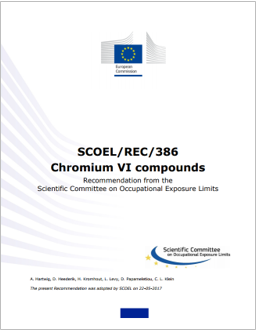Chromium VI compounds - Recommendation SCOEL
| ID 4546 | | Visite: 4402 | Documenti Chemicals UE | Permalink: https://www.certifico.com/id/4546 |
Chromium VI compounds
Recommendation from the Scientific Committee on Occupational Exposure Limits
The critical effect of the occupational inhalation of hexavalent chromium (CrVI) -containing compounds is lung cancer. In addition, occupational exposure can lead to nephrotoxicity, hypersensitivity (sensitization), corrosion of the skin, irritation of the respiratory tract and gastrointestinal tract. Cr VI compounds have been classified as a carcinogen, in Category 1 based on both humans and animal data by IARC.
Most Cr VI compounds are classified by the European Union in Category 1B (substance presumed to be carcinogenic to humans).
The exceptions are chromium trioxide, zinc chromate and zinc potassium chromate which are classified in Category 1A (substance known to be carcinogenic to humans). Reevaluation of the information on the mode of action underlying carcinogenicity has resulted in the conclusion that in case of CrVI the formation of ternary DNA adducts are relevant. These DNA lesions are not easily repaired and eventually may lead to the outgrowth of repair-deficient cell clones exerting genomic instability. Thus, Cr VI acts as a directly genotoxic carcinogen for which no threshold can be assumed and for which, linear extrapolation is commonly applied by SCOEL in this situation if the available data permits.
...
Contents
1. CHEMICAL AGENT IDENTIFICATION AND PHYSICO-CHEMICAL PROPERTIES
2. EU HARMONISED CLASSIFICATION AND LABELLING
3. CHEMICAL AGENT AND SCOPE OF LEGISLATION
4. EXISTING OCCUPATIONAL EXPOSURE LIMITS
5. OCCURRENCE, USE AND OCCUPATIONAL EXPOSURE
5.1. Occurrence
5.2. Production and use information
5.3. Occupational exposure
5.4. Routes of exposure and uptake
6. MONITORING EXPOSURE
6.1. External exposure
6.2. Internal exposure/Biomonitoring of exposure
7. HEALTH EFFECTS
7.1. Toxicokinetics (absorption, distribution, metabolism, excretion)
7.1.1. Human and animal data
7.1.2. Animal data
7.1.3. In vitro data
7.1.4. Toxicokinetic modelling
7.1.5. Biological monitoring
7.2. Acute toxicity
7.2.1. Human data
7.2.2. Animal data
7.3. Specific Target Organ Toxicity/Repeated Exposure
7.3.1. Human data
7.3.2. Animal data
7.4. Irritancy and corrosivity
7.4.1. Human data
7.4.2. Animal data
7.5. Sensitisation
7.5.1. Human data
7.6. Genotoxicity
7.6.1. Human data
7.6.2. Animal data
7.6.3. In vitro
7.7. Carcinogenicity
7.7.1. Human data
7.8. Reproductive toxicity
7.8.1. Human data
7.8.2. Animal data
7.9. Mode of action and adverse outcome pathway considerations
7.10. Lack of specific scientific information
8. CANCER RISK ASSESSMENT
9. GROUPS AT EXTRA RISK
10. REFERENCES
Fonte: Commissione Europea 2017 - SCOEL/REC/386
Articoli correlati:
Triossido di Cromo: il 21 Settembre 2017 termina l'uso in UE
Tags: Chemicals Reach Regolamento CLP
